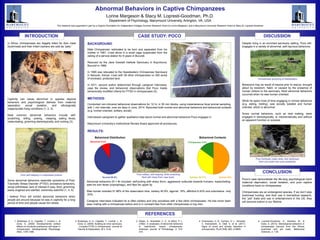Report
Share

Recommended
Recommended
More Related Content
Similar to FINAL EPA Poster 2015
Similar to FINAL EPA Poster 2015 (17)
What are socioecology and sociobiology What can they tell us about .pdf

What are socioecology and sociobiology What can they tell us about .pdf
Essay on the Adverse Effects of Anthropomorphism on Human Behavior and Percep...

Essay on the Adverse Effects of Anthropomorphism on Human Behavior and Percep...
FINAL EPA Poster 2015
- 1. INTRODUCTION 11 1. Bradshaw, G. A., Capaldo, T., Lindner, L., & Grow, G. (2009). Developmental context effects on bicultural posttrauma self repair in chimpanzees. Developmental Psychology, 45(5). 1376-1388. 2. Bradshaw, G. A., Capaldo, T., Lindner, L., & Grow, G. (2008). Building an inner sanctuary : Complex PTSD in chimpanzees. Journal of Trauma & Dissociation, 9(1). 9-34. 3. Walsh, S., Bramblett, C. A., & Alford, P. L. (1982). A vocabulary of abnormal behaviors in restrictively reared chimpanzees. American Journal of Primatology, 3, 315- 319. 4. Ferdowsian, H. R., Durham, D. L., Kimwele, C, Kranendonk, G, Otali, E, et al. (2011). Signs of mood and anxiety disorders in chimpanzees. PLoS ONE, 6(6): e19855. 5. Lopresti-Goodman, S., Kameka, M., & Dube, A. (2013). Stereotypical behaviors in chimpanzees rescued from the African bushmeat and pet trade. Behavioral Sciences, 3, 1-20. al Abnormal Behaviors in Captive Chimpanzees Lorine Margeson & Stacy M. Lopresti-Goodman, Ph.D. Department of Psychology, Marymount University, Arlington, VA, USA This research was supported in part by a Virginia Foundation for Independent Colleges Summer Research Grant to Lorine Margeson, and a Marymount University Research Grant to Stacy M. Lopresti-Goodman In Africa, chimpanzees are illegally killed for their meat (bushmeat) and their infant orphans are sold as “pets.” Despite living in an enriched sanctuary setting, Poco still engages in a variety of abnormal, self-injurious behaviors. Poco’s case demonstrate the life-long psychological harm maternal deprivation, social isolation, and poor captive conditions have on chimpanzees. Chimpanzees are an endangered species. If we don’t stop bushmeat hunting, and their use in biomedical research, the “pet” trade and use in entertainment in the US, they will become extinct in our lifetime. BACKGROUND: Male Chimpanzee, estimated to be born and separated from his mother in 1981. Lived alone in a small cage suspended from the ceiling of a service station for 9 years in Burundi. Rescued by the Jane Goodall Institute Sanctuary in Bujumbura, Burundi in 1989. In 1995 was relocated to the Sweetwaters Chimpanzee Sanctuary in Nanyuki, Kenya. Lives with 38 other chimpanzees on 200 acres of enclosed, protected land. In 2011, second author determined through caregiver interviews, case file review, and behavioral observations that Poco meets behaviorally modified criteria for PTSD in chimpanzees (5). Abnormal behaviors (N = #) included: self-poking with sharp thorn, aggressive outbursts towards humans, masturbating, eats his own feces (coprophagy), and flips his upper lip. Was human oriented 51.88% of the observation time, solitary 40.9%, agonist .16%, affinitive 6.43% and submissive only .63% Caregiver interviews indicated he is often solitary and only socializes with a few other chimpanzees. He has never been seen mating with a chimpanzee before and is in constant fear from other chimpanzees or big men. Captivity can cause abnormal or species atypical behaviors and psychological distress from maternal separation, social isolation, and ethologically inappropriate living conditions (1, 2, 3). Most common abnormal behaviors include self- scratching, -biting, -poking, -clasping, eating feces, masturbating, grooming stereotypically, and rocking (3). METHODS: Conducted non-intrusive behavioral observations for 12 hr, in 30 min blocks, using instantaneous focal animal sampling, with 1 min intervals, over six days in June, 2014. Recorded both normal and abnormal behaviors and behavioral contexts (e.g. human oriented, solitary, social). Interviewed caregivers to gather qualitative data about normal and abnormal behaviors Poco engages in. Marymount University’s Institutional Review Board approved all procedures. Poco self-clasping in a depressed posture. © Jane Goodall Institute RESULTS: Normal 90.6% Abnormal 9.4% Behavioral Distribution Behavioral Contexts Chimpanzee 5.6% Solitary 36.17% Human 46% Poco solitary, self-clasping, while scratching flesh with sharp thorn (see inset). CASE STUDY: POCO DISCUSSION CONCLUSION REFERENCES Some abnormal behaviors resemble symptoms of Post- Traumatic Stress Disorder (PTSD); avoidance behaviors, social withdrawal, lack of interest in play, food, grooming, easily angered and startled, extremely watchful (1, 4, 5). I believe Poco will exhibit abnormal behaviors when people are around because he was in captivity for a long period of time and people cause him stress. Behaviors may be result of trauma prior to rescue, brought about by boredom, habit, or caused by the presence of human visitors to the sanctuary. Most abnormal behaviors occurred when he was human oriented. While he spent most of time engaging in normal behaviors (e.g. eating, resting), was socially isolated and human oriented, which is abnormal. Some normal behaviors, such as nest making, were engaged in stereotypically, or mechanistically and without an apparent function or purpose. Chimpanzees grooming at Sweetwaters. Poco frantically made nests, then destroyed them and made new ones repeatedly.
Editor's Notes
- 1